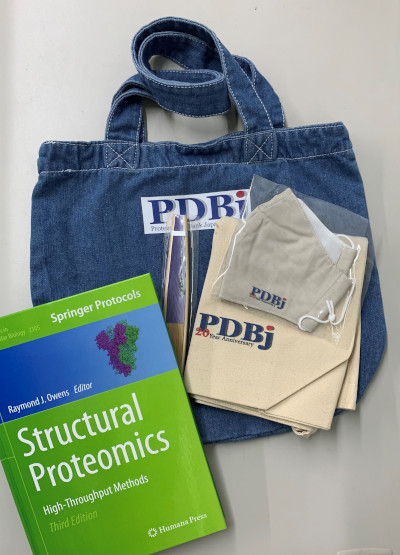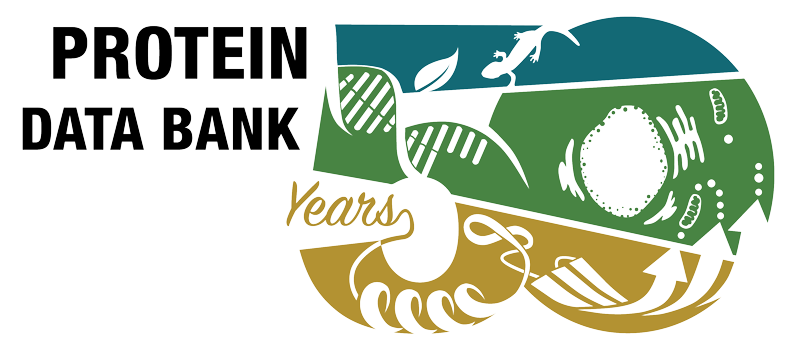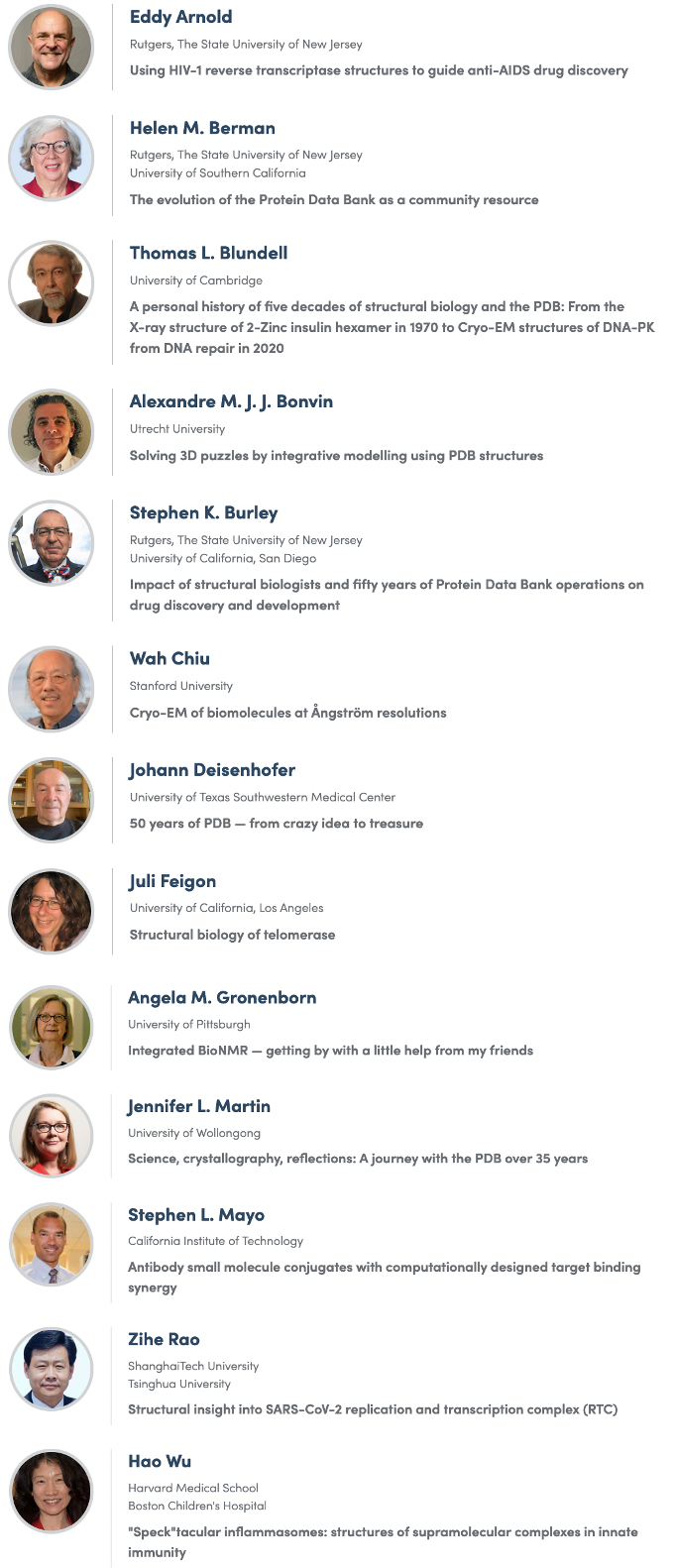[wwPDB] Time-stamped Copies of wwPDB Archives
A snapshot of the PDB Core archive (ftp://ftp.wwpdb.org) as of January 5th, 2021 has been added to ftp://snapshots.wwpdb.org and ftp://snapshots.pdbj.org. Snapshots have been archived annually since 2005 to provide readily identifiable data sets for research on the PDB archive.
The directory 20210105 includes the structure and experimental data for the 173,005 PDB entries available at that time. Atomic coordinate and related metadata are available in PDBx/mmCIF, PDB, and XML file formats. The date and time stamp of each file indicates the last time the file was modified. The snapshot of PDB Core archive is 822 GB.
A snapshot of the EMDB Core archive (ftp://ftp.ebi.ac.uk/pub/databases/emdb/) as of January 4, 2021 can be found in ftp://ftp.ebi.ac.uk/pub/databases/emdb_vault/20210104/ and ftp://snapshots.pdbj.org/20210105/. The snapshot of EMDB Core archive contains map files and their metadata within XML files for both released and obsoleted entries (13731 and 142, respectively) and is 2.9 TB in size.
[ wwPDB News ]
[wwPDB] Biocurator Milestone: >10,000 Depositions Processed
 RCSB PDB Biocurator Dr. Brian P. Hudson
talking about the SARS-CoV-2 main protease in February 2020
RCSB PDB Biocurator Dr. Brian P. Hudson
talking about the SARS-CoV-2 main protease in February 2020
Congratulations to the wwPDB biocurator Dr. Brian Hudson on processing over 10,000 PDB depositions! Dr. Hudson received his PhD in Chemistry from the California Institute of Technology and has an expertise in X-ray crystallography and cryo-electron microscopy. He has joined PDB in 2010 and has established himself as a highly qualified professional with deep understanding of scientific data and various experimental techniques and dedication to exceptional quality data curation. He was one of the EM data curation pioneers who curated over 1000 of EM map entries before the OneDep system was established. We congratulate Dr. Hudson with this exciting accomplishment and look forward to his further career success!
[ wwPDB News ]
[wwPDB] Deposition of Half-maps for Certain EM Entries to Become Mandatory
From February 25, 2022, deposition of half-maps for single-particle, single-particle-based helical, and sub-tomogram averaging reconstructions to the EM Data Bank (EMDB) will become mandatory. This change is in response to a long-standing community request to the wwPDB EMDB Core Archive and was also a recommendation from the 2020 wwPDB single-particle cryo-EM data-management workshop (white paper in preparation). Several recommendations from this workshop have already been implemented in the wwPDB OneDep system. These include improvements to wwPDB validation reports and enhancements for capturing metadata via the deposition interface.
Mandatory half-maps must be unfiltered, unmasked, unsharpened, and positioned in the same coordinate-space and orientation as the primary map such that they superimpose. The availability of half-maps will contribute to improved validation of EM structures as reflected in the wwPDB validation reports.
wwPDB strongly urges developers of cryo-EM processing software for the affected modalities to implement support for output of such half-maps (if this is not already available).
Any queries about this policy change can be directed to info@wwpdb.org.
[ wwPDB News ]
The announcement of PDB50 Anniversary Symposum in Asia PDBj poster prize winner
PDBj successfully organized the PDB 50th Anniversary Symposium in Asia (online) on November, 24, 2021 with active participation of more than 300 international and local scientists.
At the poster session, we had 78 poster presentations mainly from Asia, and among which we judged 57 posters by young scientists for PDBj Poster Prize targets.
We are pleased to announce four awardees of the prize as below and would like to congratulate on their successful presentations:
- ID
- SP2-9
- Title
- Structural Insights into the Clustering and Activation of Tie2 Receptor Mediated by Tie2 Agonistic Antibody
- Presenter's Name
- Gyunghee Jo
- Affiliation
- Center for Biomolecular and Cellular Structure, Institute for Basic Science(IBS), Republic of Korea
- Job Title
- Postdoctoral Research Associates
- ID
- SP4-12
- Title
- Crystal structure of methylenetetrahydrofolate reductase from Sphingobium sp. SYK-6
- Presenter's Name
- Hongyang Yu
- Affiliation
- Structural Biology Research Center(SBRC), Institute of Materials Structure Science, High Energy Accelerator Organization (KEK) , and Department of Materials Structure Science, School of High Energy Accelerator Science, The Graduate University for Advanced Studies (SOKENDAI), Japan
- Job Title
- Post Doctoral Fellow
- ID
- SP4-14
- Title
- Exploring the structural aspects of a novel phospholipid-binding protein
- Presenter's Name
- Angshu Dutta
- Affiliation
- Department of Biosciences and Bioengineering, Indian Institute of Technology Guwahati, India
- Job Title
- PhD student
- ID
- SP4-40
- Title
- A new trend of protein crystallography: Polymorph analysis using hierarchical clustering of diffraction data
- Presenter's Name
- Hiroaki Matsuura
- Affiliation
- RIKEN/SPring-8 Center, Japan
- Job Title
- Postdoctoral Researcher
Awardees will receive a certificate together with commemorative gift.
Posters are reviewed by the following poster judges. We appreciate their significant cooperation as well as all the presentaters and participants.
Takao Arimori (Osaka Univ), Shuya Fukai (Kyoto Univ), Toshimichi Fujiwara (Osaka Univ), Hiroshi Hashimoto (Univ of Shizuoka), Kosuke Hashimoto (Osaka Univ), Kunio Hirata (RIKEN/SPring-8 Center), Takayuki Kato (Osaka Univ), Takeshi Kawabata (Protein Research Foundation), Akihiro Kawamoto (Osaka Univ), Jun-ichi Kishikawa (Osaka Univ), Chojiro Kojima (Yokohama National Univ), Hiroyasu Koteishi (Osaka Univ), Genji Kurisu (Osaka University), Yoh Matsuki (Osaka Univ), Yohei Miyanoiri (Osaka Univ), Kenji Mizuguchi (Osaka Univ), Atsushi Nakagawa (Osaka Univ), Chioko Nagao (Osaka Univ), Nobutaka Numoto (Tokyo Medical and Dental Univ), Takuji Oyama (Yamanashi University), Toshihiko Sugiki (Osaka Univ), Masakazu Sugishima (Kurume Univ), Junichi Takagi (Osaka Univ), Hiroko Takazaki (Osaka Univ), Hideaki Tanaka (Osaka Univ), Sachiko Toma-Fukai (NAIST), Eiki Yamashita (Osaka Univ) (Ordered alphabetically of family name)
Last but not least, this event was sponsored by the Protein Research Foundation. It was organized as a part of the 59th annual meeting of the Biophysical Society of Japan and as the international seminar of Institute for Protein Research, Osaka University. We also appreciate their various supports.
November 24, 2021 (Wed), "PDB50 Anniversary Symposium in Asia" will be held online
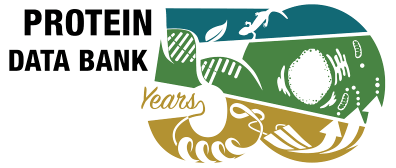
In commemoration of PDB's 50 year anniversary, "PDB Asia 50 Anniversary Symposium - At the Cutting Edge of Structural Biology in Asia and Protein Data Bank's 50 Years of History -" will be held with the following contents.
- Date
- November 24, 2021 (Wed) * all the time and date are shown in JST(=UTC+9)
- Venue
- Online
- Background and Abstract
-
In 1971, the structural biology community established the single global archive for 3D macromolecular structure data: the Protein Data Bank (PDB). Approximately one fourth of the entire PDB data originated from Asia. In 2000, Protein Data Bank Japan (PDBj) started on-site data processing as a newly founded Asian hub for PDB data resource. Since 2001, PDBj has provided our newly developed online Data-out services available freely and publicly through our own web site (https://pdbj.org), which we have enhanced through the years. With the establishment of the worldwide PDB in 2003, we have served as one of its regional data centers, collaborating on Data-in and Data-out activities on a global scale.
In 2021, we are celebrating the 50th anniversary of our single global archive, especially this time in Asia, and want to discuss the frontier of the Structural Biology in Asia.
The one-day online symposium consists 2 sessions: e-poster presentations and a series of lectures. Students and postdoctoral fellows are especially encouraged to join and will be eligible for poster prizes. Early and late stage career scientists are encouraged to submit an abstract for poster presentation during the symposium.
The event will be recorded and made available to registered participants after the meeting.
- Language
- English
- Participation/Presentation Fee
- Free

- Schedule
-
Poster session (jointly organized as an International IPR Seminar, Institute for Protein Research, Osaka University)
10:00-10:10 Opening and introduction 10:10-10:50 Presentation by odd-number IDs 10:50-11:00 Break 11:00-11:40 Presentation by even-number IDs - Organizers
-
- Genji Kurisu (Institute for Protein Research, Osaka University; PDBj)
- Toshimichi Fujiwara (Institute for Protein Research, Osaka University; PDBj)
- Sponsor
- Protein Research Foundation
- Registration Period
-
- Registration for Poster Presentation
- September 6, 2021 (Mon) - October 17, 2021 (Sun) 23:59 (JST)Note: Registration will be closed earlier when the number of posters reach 100.
- Registration for Participation
- September 6, 2021 (Mon) - November 8, 2021 (Mon) 23:59 (JST)
- Submission of Poster Material
- November 1, 2021 (Mon) - November 8, 2021 (Mon) 23:59 (JST) November 12, 2021 (Fri) 17:00 (JST)
- Registration for Presentation/Participation
- Please registor from here.
- Notes
-
- This symposium will be held as a satellite event at the 59 annual meeting of the Japanese Society of Biophysics. In case you are registered to participate in the annual meeting, please also register to participate in this symposium, for the purpose of operation and administration.
- Even if you register for this event, you cannot participate in the annual program.
- Acquired personal information is used only within the scope of the purpose of acquisition.
- Points of Registration for Poster Presentation
-
- Eligibility for Presentation Application
- Any researchers can apply the presentation. You don't have to be a member of the Japanese Society of Biophysics. You can apply for only one presentation as presentater. Presentations at the Biophysical Society annual meeting are not counted here, that is you can be presented at both this poster session and the annual meeting.
- Themes of Poster
-
- Protein Structure and Supramolecular complexes
- RNA/DNA molecular machines
- Application of Structural Biology
- X-ray/XFEL
- NMR
- 3DEM
- Bioinformatics/Protein Structure Prediction
- Number of Presentation
- 100 (Registration will be closed earlier when the number of posters reach 100.)
- Confirmation Mail
- When the registration is completed, a notice email will be sent automatically. Poster numbers (IDs) and presentation registration procedures will be sent separately by the end of October 2021. Please avoid registering with a free email address because it may be recognized as spam.
- PDBj Poster Prize
- Excellent posters prepared by students and post-doc students will be awarded.
- Submission of Presentation Material
- Please register your presentation material (still image or video) from November 1, 2021 (Mon) to November 8, 2021 (Mon) (JST: 23:59) on the Japan Society of Biophysics website using the confit system. During the registration period, you can review, modify, or cancel your registration. We will not accept any modification or registration after the registration period.
- Secretariat
-
c/o Protein Data Bank Japan, Institute for Protein Research, Osaka University, JapanEmail: db_sec@protein.osaka-u.ac.jpTel: +81-6-6879-4311
Anniversary symposium (jointly organized as the satellite event of the The Satellite Event of the 59th Annual Meeting of the Biophysics Society of Japan)
| Session 1: Chaired by Prof. Haruki Nakamura (Osaka University) | |
|---|---|
| 13:30-14:15 | "50 years of PDB history in Asia" Genji Kurisu (Institute for Protein Research, Osaka University; PDBj, Japan) |
| "CryoEM structure of small heat shock protein" Kyeong Kyu Kim (Sungkyunkwan University School of Medicine, Republic of Korea) | |
| Session 2: Chaired by Prof. Atsushi Nakagawa (Institute for Protein Research, Osaka University) | |
| 14:25-15:10 | "Structure of the sodium-dependent phosphate transporter reveals insights into human solute carrier SLC20" Yuh-Ju Sun (Institute of Bioinformatics and Structural Biology, National Tsing Hua University, Taiwan) |
| "Molecular movies and beyond" So Iwata (Graduate School of Medicine, Kyoto University, Japan) | |
| Session 3: Chaired by Prof. Toshimichi Fujiwara (Institute for Protein Research, Osaka University) | |
| 15:20-16:05 | "Membrane protein function by NMR" Ichio Shimada (RIKEN Center for Biosystems Dynamics Research, Japan) |
| "Structural biology by an advanced electron cryomicroscope with atomic resolution and high-speed imaging" Keiichi Namba (Graduate School of Frontier Biosciences, Osaka University, RIKEN SPring-8 & BDR, Japan) | |
| Session 4: Chaired by Prof. Kenji Mizuguchi (Institute for Protein Research, Osaka University) | |
| 16:15-17:00 | "Structural and mechanistic dissection of the Wnt signaling pathway" Wenqing Xu (National Facility for Protein Science in Shanghai (NFPS), ShanghaiTech University) |
| "A new era in structural biology: the impact of structure prediction using AI methods" Sameer Velankar (Protein Data Bank in Europe, European Molecular Biology Laboratory - European Bioinformatics Institute) | |
| 17:00-17:05 | Closing |
[wwPDB] November Workshops on Open-Source Tools for Chemistry

Join the Royal Society of Chemistry for two webinars on Protein Data Bank at 50: Accessing, Understanding, and Assessing PDB Data
As part of their series of Workshops on Open-Source Tools for Chemistry, the Chemical Information and Computer Applications Group of the Royal Society of Chemistry will be hosting two free virtual events in honor of PDB50.
Protein Data Bank at 50: Accessing, Understanding, and Assessing PDB Data
Day 1: Tuesday November 16, 2021 | 3-5pm GMT
- History of the Protein Data Bank (PDB) and the Worldwide PDB, Stephen K. Burley, RCSB Protein Data Bank (RCSB PDB)
- PDBx/mmCIF Data Standard and PDB Data Deposition with OneDep, Ezra Peisach and Jasmine Young, RCSB PDB
- Small Molecules in the PDB, Chenghua Shao, RCSB PDB
- OneDep Tutorial, Jasmine Young and Ezra Peisach, RCSB PDB
Day 2: Thursday November 18 2021 3-5pm GMT
- wwPDB Validation: Assessing the Quality of PDB structures, John Berrisford, Protein Data Bank in Europe (PDBe)
- How to Interpret the Quality of a PDB Structure using the wwPDB validation report, David Armstrong, John Berrisford, Jack Turner, PDBe
- 3D Visualization of PDB Data with the Mol* viewer James Tolchard, PDBe
- Impact of AI and Future of PDB Data: Next Generation PDB Archive, Sameer Velankar (PDBe)
- Round Table Discussion, Sameer Velankar (PDBe) and Stephen K. Burley (RCSB PDB)
After these workshops, attendees should be able to:
- Access and appropriately use the wwPDB OneDep system for macromolecular structure depositions
- Understand how small molecule data in the PDB is organized and how to access it
- Evaluate the quality and accuracy of a PDB structure using the wwPDB validation report
- Understand how to use the Mol* molecular viewer to visualize PDB structures
- Appreciate wwPDB plans for establishing a Next Generation PDB Archive
Please register to attend these Open-Source Tools for Chemistry Workshops.
[ wwPDB News ]
[wwPDB] Obituary for John Westbrook

John Westbrook at the 2017 Congress and General Assembly of the International Union of Crystallography in Hyderabad, India
John D. Westbrook Jr. (1957-2021), Research Professor at Rutgers University and Data & Software Architect Lead for the RCSB PDB, passed away on October 18, 2021.
He was incredibly beloved and respected by his colleagues at Rutgers and throughout the world, known for his dry wit and endless enthusiasm for thinking about all aspects of data and data management.
John had a long and highly successful career developing ontologies, tools, and infrastructure in data acquisition, validation, standardization, and mining in the structural biology and life science domains. His work established the PDBx/mmCIF data dictionary and format as the foundation of the modern Protein Data Bank (PDB) archive (wwPDB.org).
More than twenty-five years ago, while still a graduate student, John recognized the importance of a well-defined data model for ensuring delivery of high quality and reliable structural information to data users. He was the principal architect of the mmCIF data representation for biological macromolecular data. Based on a simple, context-free grammar (without column width constraints), data are presented in either key-value or tabular form. All relationships between common data items (e.g., atom and residue identifiers) are explicitly documented within the PDBx Exchange Dictionary (mmcif.wwpdb.org). Use of the PDBx/mmCIF format enables software applications to evaluate and validate referential integrity within any PDB entry. A key strength of the mmCIF technology is the extensibility afforded by its rich collection of software-accessible metadata.
The current PDBx/mmCIF dictionary contains more than 6.200 definitions relating to experiments involved in macromolecular structure determination and descriptions of the structures themselves. The first implementation of this schema was used for the Nucleic Acid Database, a data resource of nucleic acid-containing X-ray crystallographic structures. Today, this dictionary underpins all data management of the PDB. Since 2014, it has served as the Master Format for the PDB archive. It also forms the basis of the Chemical Component Dictionary (wwpdb.org/data/ccd), which is used to maintain and distribute small molecule chemical reference data in the PDB.
In 2011, the Worldwide Protein Data Bank (wwPDB) PDBx/mmCIF Working Group was established to enable direct use of PDBx/mmCIF format files within major macromolecular crystallography software tools and to provide recommendations on format extensions required for deposition of larger macromolecule structures to the PDB. This was a key step in the evolution of the PDB archive, which enabled analyses of macromolecular machines, such as the ribosome, as single PDB structures (instead of split entries with atomic coordinates distributed among different x,y,z files). In 2019, mandatory submission of PDBx/mmCIF format files for deposition was announced (Adams et al. Acta Crystallographica D75, 451-454).
To ensure the success of the PDBx/mmCIF dictionary and format, John worked with a wide range of community experts to extend the framework to encompass descriptions of macromolecular X-ray crystallographic experiments, 3D cryo-electron microscopy experiments, NMR spectroscopy experiments, protein and nucleic acid structural features, diffraction image data, and protein production and crystallization protocols. Most recently, these efforts have been focused on developing compatible data representations for X-ray free electron (XFEL) methods, and for integrative or hybrid methods (I/HM). I/HM structures, currently stored in the prototype PDB-Dev archive (pdb-dev.wwpdb.org), presented new challenges for data exchange among rapidly evolving and heterogeneous experimental repositories. Proper management of I/HM structures in PDB-Dev also required extension of the PDBx/mmCIF data dictionary to include coarse-grained or multiscale models, which will be essential for studying macromolecular structures in situ using cryo-electron tomography and other bioimaging methods.
John contributed broadly to community data standards enabling interoperation and data integration within the biology and structural biology domains. His efforts have included (i) describing the increasing molecular complexity of macromolecular structure data, (ii) representing new experimental methodologies, including I/M techniques, and (iii) expanding the biological context required to facilitate broader integration with a spectrum of biomedical resources. John’s work has been central to connecting crystallographic and related structural data for biological macromolecules to key resources across scientific disciplines. His efforts have been described in more than 120 peer-reviewed publications, one of which has been cited more than 21,000 times according to the Web of Science (Berman et al. Nucleic Acids Research 28, 235-242). Eight of his most influential published papers have appeared in the International Tables of Crystallography.
John has also done yeoman service to the crystallographic community over many years and was recognized with the inaugural Biocuration Career Award from the International Society for Biocuration in 2016.
For the International Union of Crystallography, John served on the Commission for Maintenance of CIF Standard (COMCIFS), the Working Group on Data Diffraction Deposition (DDDWG), and the Committee on Data (CommDat). He also served as an Associate Editor for Acta Crystallographica Section F.
John was a long-standing member of the American Crystallographic Association, and served on the Data, Standards & Computing Committee. He also served on the Metadata Interest Group for the Research Data Alliance.
John is survived by his wife, Bonnie J. Wagner-Westbrook, Ed.D. and his devoted Mother-in-Law, Joan N. Wagner of Clinton Twp., NJ; many cousins including Chandler Turner (of Portsmouth, VA), Ann (Turner) Heyes (of Tasmania, Australia) and Louise (Turner) Brown (of Oakland CA).
Visitation will take place on Saturday, November 6, 2021 from 2-4pm with Memorial Service at 4pm. All at Scarponi-Bright Funeral Home, 26 Main Street, Lebanon, NJ. Interment will be private.
Memorials can be made to Capicats or an organization of choice in his honor.
Additional information is available at Scarponi-Bright
[ wwPDB News ]
[wwPDB] PDB Turns 50
The PDB was announced on October 20, 1971 in Crystallography: Protein Data Bank Nature New Biology 233: 223 (1971) doi: 10.1038/newbio233223b0.
Today, the PDB archive contains >180,000 structures of proteins, nucleic acids, and complex assemblies that helps students and researchers understand all aspects of biomedicine and agriculture, from protein synthesis to health and disease. It is managed by the Worldwide PDB (wwPDB) organization that ensures that the PDB is freely and publicly available to the global community.
The wwPDB has been celebrating this golden anniversary with symposia and events throughout 2021.
Consider supporting 50 years of PDB's spirit of openness, cooperation, and education with a donation to the wwPDB Foundation. The wwPDB Foundation was established in 2010 to raise funds in support of the outreach activities of the wwPDB. The Foundation raised funds to help support PDB50 events, workshops, and educational publications.
The Foundation is chartered as a 501(c)(3) entity exclusively for scientific, literary, charitable, and educational purposes.

Individual donations ($100 or more suggested) are recognized with a special gift of a hemoglobin lapel pin.
[ wwPDB News ]
[wwPDB] PDB50 Anniversary Symposium in Asia
The symposium At the Cutting Edge of Structural Biology in Asia and Protein Data Bank's 50 Years of History will be held virtually on November 24.
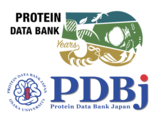
[ wwPDB News ]
[wwPDB] Biocurator Milestone: >10,000 Depositions Processed
Congratulations to biocurators Dr. Sutapa Ghosh and Dr. Monica Sekharan on processing over 10,000 PDB depositions. They are the second and third biocurators to reach this milestone. Yumiko Kengaku reached this milestone in April 2021.
Dr. Ghosh received her PhD in structural biology from the University of Calcutta and joined the PDB after working in industry in structure-based drug design. Dr. Sekharan received her PhD in Biological Chemistry from the University of Washington with expertise in NMR spectroscopy. During their 15-year career at the PDB, many depositors have trusted their professional skills in accurate and comprehensive data analysis and representation. Their deep scientific knowledge, profound data curation expertise and commitment to excellence contributed to the high quality data archive for the benefit of the scientific community. We congratulate Drs. Ghosh and Sekharan with this exciting accomplishment and look forward to their future successes.

RCSB PDB Biocurators Dr. Sutapa Ghosh and Dr. Monica Sekharan
[ wwPDB News ]
[wwPDB] PDBx/mmCIF data files to include PI information

PI name, email, and ORCiD ID will be publicly available in PDBx/mmCIF data files starting September 24, 2021
wwPDB continues to support research, education, and drug discovery worldwide. Open access to PDB data has helped researchers in structure-guided discovery and development of anti-coronavirus drugs, vaccines and neutralizing antibodies. When researchers analyze existing PDB structures, such as working on a similar structure, they may often need additional information impossible to retrieve from the PDB entry file alone. In particular, it is not possible to obtain a point of contact in cases where there is no associated primary publication for an entry.
Following a recommendation from the IUCr Commission on Biological Macromolecules and the IUCr Committee on Data, wwPDB will make public the PI name, email address, and ORCiD ID for initial PDB depositions or re-submissions made, starting September 24, 2021. This will enable contact with the authors of every released PDB structure as of that date. This release will also align the PDB with the standard practices of providing corresponding author information by scientific journals
The dated acceptance of these PDB Terms and Conditions described above will be captured within the OneDep system. The responsible depositor who creates the deposition should make entry PI(s) aware of the policy change to include PI name, email address, and ORCiD in public PDBx/mmCIF files.
[ wwPDB News ]
[wwPDB] Improved Access to Chemical Component Definitions and Archive Inventories
 Individual Chemical Component Dictionary entries and new archive inventory lists are now available for download
Individual Chemical Component Dictionary entries and new archive inventory lists are now available for download
Improved access to small molecule definitions (New tree: /pdb/refdata/)
Individual Chemical Component Dictionary (CCD) and Biologically Interest molecule Reference Dictionary (BIRD) definitions are now accessible in a new FTP tree in the PDB archive. In response to user requests, these individual CCD and BIRD entry files can be found at /pdb/refdata/chem_comp/ and /pdb/refdata/bird/, respectively with last character hash as sub-directory.
For example:
- /pdb/refdata/chem_comp/C/D8C/D8C.cif
- /pdb/refdata/bird/prd/8/PRD_001068.cif
Improved access to information about PDB archive holdings (New tree: /pdb/holdings/)
New inventory data files offer a quick overview of data in the archive. These files are in the extensible JSON format, and can be found under the new /pdb/holdings/ FTP tree.
The inventory lists provided include:
- all_removed_entries.json.gz: list of removed PDB entries (obsolete, models) with entry authors, entry title, release date, obsolete date , and superseding PDB ID, if any.
- current_file_holdings.json.gz: List of released PDB entries and file types present for each entry in the PDB Core Archive (e.g., coordinate data, experimental data, validation report, ...)
- obsolete_structures_last_modified_dates.json.gz: List of obsolete PDB entries with last time of PDBx/mmCIF file modification
- refdata_id_list.json.gz: List of released chemical reference entries, content types (e.g., Chemical Component, BIRD), and last time of reference file modification
- released_structures_last_modified_dates.json.gz: List of released PDB entries with last time of PDBx/mmCIF file modification
- unreleased_entries.json.gz: List of on-hold PDB entries, entry status, deposition date, and sequence pre-release information
The inventory (index) files historically provided in /pdb/derived_data/ will continue to be updated for the time being; they will eventually be removed from the PDB archive. Users are encouraged to utilize these new inventory files.
[ wwPDB News ]
A WEB site and movies are available for “Shapes of proteins for living things – Molecules of COVID-19”
A special WEB site and movies for Coronavirus 3D structure are now available. These resources are developed for the exhibition for young students called “Web Science Fiesta 2021”. The title of the resources is “Shapes of proteins for living things – Molecules of COVID-19”.
Using Molmil, we show 3D structures of a virion, spike proteins, receptors and antibodies, mutations of delta variant, antibody cocktail, remdesivir and drugs. Students and everyone are welcome to learn about how to attack COVID-19 !
The address of the WEB site is as follows:
https://numon.pdbj.org/covid19/index.html.en
The addresses of the movies are as follows.
Although the audio narrations are Japanese, you can choose English subtitle.
Movie [YouTube] for Science Fiesta(5min)
Movie [YouTube] short version(8min)
Movie [YouTube] long version(14min)

|

|
[wwPDB] PDB adopts a standard Creative Commons open source license
wwPDB manages the PDB Core Archives as a public good according to the FAIR Principles. In support of the FAIR objectives, wwPDB has replaced its historical data access license with a standard open source license from Creative Commons, the CC0 1.0 Universal (CC0 1.0) Public Domain Dedication.
The new CC0 license provides the same open access as the prior license. PDB data remain freely available to all PDB Users including commercial users.
The 2021 wwPDB Charter Agreement and Usage Policy have been updated to reflect the new license.
[ wwPDB News ]
2021 PDBj web server transition
- Advanced Search has been merged with Quick Search
- A new "Search PDBj RDB" service is available, which is a graphical interface around our SQL service, to make it easier for users unfamiliar with SQL to search using any data part of the offical mmCIF and our pdbjplus data.
- The CIF-Query and XML-Query service have been discontinued, but the functionality has been integrated in our search system via the "Download results", where any arbitrary data category/item can be obtained from our RDB for the search matches in mmCIF, mmJSON or arbitrary JSON formats
- A new PDBj data archive has been prepared (https://data.pdbjbk1.pdbj.org/), where we have re-arranged our data files into a more logical and cleaned-up manner.
- The PDBMLplus format has been deprecated in favour for the mmJSON ones, which are available at https://data.pdbjbk1.pdbj.org/pdbjplus/data/cc/mmjson-plus/ and at each individual PDB entry page.
- The sequence navigator/neighbor interface has been renewed and the superposition functionality has been moved from the server-side using legacy PDB flat files to the client-side with Molmil using mmJSON files.
- The PDB entry page's Molmil interface (AU/BU) has been renewed.
- The EDMap Molmil interface has been renewed.
- eF-site has been integrated in the Mine PDB entry pages and the Molmil interface has been renewed.
- The Promode Elastic interface has been renewed.
- Our REST services have been renewed.
- Additional data has been added to our pdbjplus data (archive and files).
- The RDB delta files have been deprecated and replaced by our updater service
[wwPDB] wwPDB to switch to version 3 of the EMDB data model
From February 9, 2022, the wwPDB EMDB Core Archive will exclusively support version 3 of its data model and retire version 1.9.6 header files from the archive. The switch will involve several changes regarding file provision by the archive and this article outlines these changes.
Since the inception of OneDep in 2015, the EMDB Core Archive (EMBL-EBI: ftp.ebi.ac.uk/pub/databases/emdb/, PDBj: ftp.pdbj.org/pub/emdb/ or data.pdbjbk1.pdbj.org/pub/emdb/, wwPDB mirror site: ftp.wwpdb.org/pub/emdb/) has maintained two versions of its data model in parallel and also two versions of the header file for each entry. Currently, the official EMDB data model is version 1.9.6, while version 3, which facilitates a richer representation of the metadata about EMDB entries, was introduced in 2015.
Version 3 has now been finalized, and EMDB will therefore change its official data model version from v1.9.6 to v3. This will involve three changes to the EMDB Core Archive as of February 9, 2022:
- The current EMDB data model, defined in an XSD schema in a file named emdb.xsd and located in <EMDB Core Archive>/doc/XML-schemas/emdb-schemas/current/, will change to the latest version of the v3 data model (at present v3.0.2.6).
- The official header file for each entry in the EMDB Core Archive, an XML file named emd-xxxxx.xml, will become a v3 XML file that follows the structure of the latest version of the v3 data model.
- The EMDB Core Archive will cease provision of v1.9.6 header files for all entries.
Currently, for an entry EMD-xxxxx in the EMDB core archive located at <EMDB Core Archive>/structures/EMD-xxxxx/header/, the following header files are provided:
- Official header file: emd-xxxxx.xml
- Header file for data model v3: emd-xxxxx-v30.xml
- Header file for data model v1.9.6: emd-xxxxx-v19.xml
where emd-xxxxx.xml at present is a copy of the file emd-xxxxx-v19.xml, adhering to v1.9.6 of the EMDB data model.
From 9th February 2022 onward, for any entry, the following header files will be provided:
- Official header file: emd-xxxxx.xml
- Header file for data model v3: emd-xxxxx-v30.xml
where emd-xxxxx.xml will be a copy of emd-xxxxx-v30.xml, supported by v3 of the EMDB data model.
For any further information please email info@wwpdb.org.
[ wwPDB News ]
PDBj FTP Archive reorganization
From September 1st 2021, our ftp and ftp-versioned archives will be reorganized as follows:
| (1) ftp.pdbj.org | wwPDB common area for /pub (i.e., pdb and emdb) only (same as wwPDB's and RCSB's core FTP archive) |
|---|---|
| (2) ftp-versioned.pdbj.org | The same as before, this only contains the versioned PDB data |
| (3) data.pdbjbk1.pdbj.org | This contains both (1) and (2), and additionally contains PDBj generated content and data for PDBj's other archives (no changes since its release) |
With this reorganization, for users that obtain data other than the core wwPDB data from (1) (i.e. other than /pub), please switch over to our new data archive (data.pdbjbk1.pdbj.org). For users that only use the core wwPDB data archive, the reorganization will have no effect. Please also see our help page about the archive contents for more information about the organization of our new data archive.
In addition, from September 1st 2021, the PDBMLadd files (PDBj generated data stored in XML format) will no longer be available. The mmJSON version of the data will still be available at our data archive and via the Mine 2 RDB, and we recommend users of this data to transition to this more modern format.
If you have any questions regarding this matter, please contact us.
[wwPDB] Extended PDB IDs and PDB DOIs now available in PDBx/mmCIF files

Journals, PDB users, and software developers should review code and begin to prepare for the change in format of PDB IDs and inclusion of PDB DOIs in PDBx/mmCIF files
wwPDB, in collaboration with the PDBx/mmCIF Working Group, has set plans to extend the length of ID codes for PDB and Chemical Component Dictionary (CCD) ID entries in the future. These extended formats are not supported by the legacy PDB file format.
As announced previously, wwPDB has extended PDB ID length to eight characters prefixed by ‘PDB’, e.g., pdb_00001abc.
Each PDB ID is issued a corresponding Digital Object Identifier (DOI), often required for manuscript submission to journals and described in publications by the structure authors.
To help depositors provide information to journals, OneDep now displays the PDB ID and DOI on the submission confirmation page.
The extended PDB IDs and corresponding PDB DOIs, along with existing four character PDB IDs, are now included in the PDBx/mmCIF formatted files. Initially, this will only be available for updated and newly-released PDB entries, with an archive-wide update at a later date.
The additional accessions will be provided in the _database_2 PDBx/mmCIF category.
For example, PDB entry 1ABC will have the extended PDB ID (pdb_00001abc) and the corresponding PDB DOI (10.2210/pdb1abc/pdb).
loop_ _database_2.database_id _database_2.database_code _database_2.pdbx_database_accession _database_2.pdbx_DOI PDB 1abc pdb_00001abc 10.2210/pdb1abc/pdb WWPDB D_1xxxxxxxxx ? ?
wwPDB asks journals, users, and software developers to review code and remove related limitations.
[ wwPDB News ]
[wwPDB] PDBx/mmCIF data files to include PI information
wwPDB continues to support research, education, and drug discovery worldwide. Open access to PDB data has helped researchers in structure-guided discovery and development of anti-coronavirus drugs, vaccines and neutralizing antibodies. When researchers analyze existing PDB structures, such as working on a similar structure, they may often need additional information impossible to retrieve from the PDB entry file alone. In particular, it is not possible to obtain a point of contact in cases where there is no associated primary publication for an entry.
Following a recommendation from the IUCr Commission on Biological Macromolecules and the IUCr Committee on Data, wwPDB will make public the PI name, email address, and ORCiD ID for initial PDB depositions or re-submissions made, starting September 24, 2021. This will enable contact with the authors of every released PDB structure as of that date. This release will also align the PDB with the standard practices of providing corresponding author information by scientific journals.
The dated acceptance of these PDB Terms and Conditions described above will be captured within the OneDep system. The responsible depositor who creates the deposition should make entry PI(s) aware of the policy change to include PI name, email address, and ORCiD in public PDBx/mmCIF files.

[ wwPDB News ]
[wwPDB] Congratulations to Poster Prize Winners
 Poster Prize awardees
Poster Prize awardees
At the inaugural PDB50 meeting, ~275 posters were presented (Abstracts Day 1 | Day 2); 209 of these presentations were considered for poster prize awards.
- Best in High School: Nicholas Mamisashvili, Shelter Island High School, Molecular Dynamics Simulation of 6PEY.pdb a Novel Mutation in the Enzyme Methylenetetrahydrofolate Reductase
- Best in Undergraduate: Ijeoma Okoye, Vassar College, X-ray and Antioxidant Determination of Butein and 2’,4’-dihydroxy-3,4-dimethoxychalcone to Examine their Antimalarial Activity by Binding to Falcipain-2
- Best in Graduate: Daniel Sultanov, New York University, Mining for functional ribosomal variants in Saccharomyces cerevisiae
- Best in Postdoctoral Scholars: Seda Kocaman, National Institute of Environmental Health Sciences, Different ATP binding states of the essential AAA (ATPases Associated with various Activities)-ATPase Rix7 facilitate substrate translocation in ribosome biogenesis
Many thanks to the poster prize judges:
- BMRB: Hamid Eghbalnia
- PDBe: Genevieve Evans, John Berrisford
- PDBj: Genji Kurisu
- UConn: Bing Hao, Irina Bezsonova, Melissa Caimano
- University of Naples: Luigi Di Costanzo
- RCSB: Brian Hudson, Brinda Vallat, Cathy Lawson, Chenghua Shao,
- David Goodsell, Dennis Piehl, Ezra Peisach, Helen Berman, Irina Persikova, Joan Segura, Justin Flatt, Rachel Kramer Green, Stephen Burley, Yuhe Liang, Zukang Feng
- RIT: Paul Craig
[ wwPDB News ]
[wwPDB] EMDB becomes a partner in wwPDB
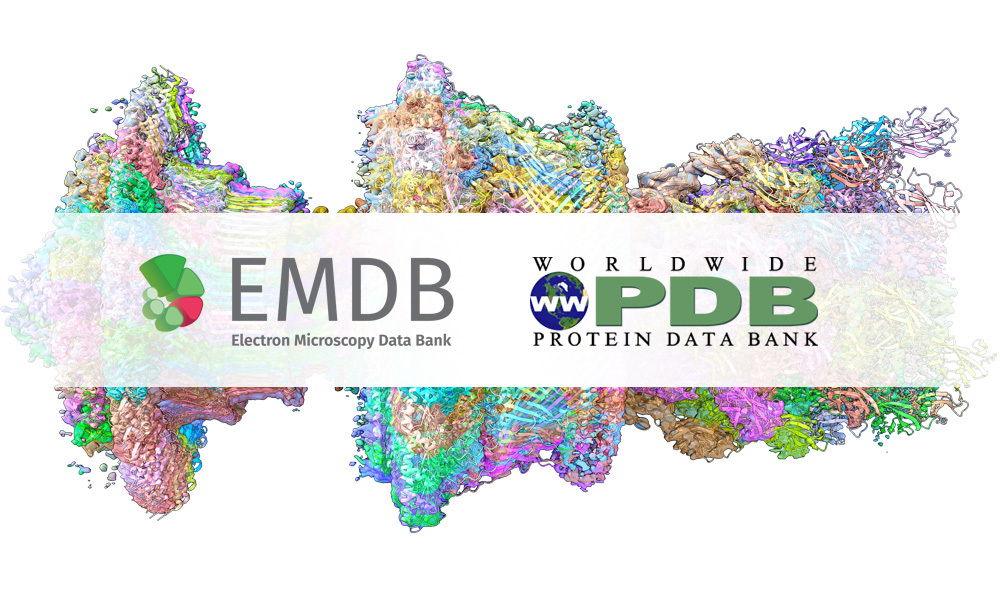
The Electron Microscopy Data Bank (EMDB), the public repository for electron cryo-microscopy maps and tomograms of macromolecular complexes and subcellular structures, is now an official partner in the Worldwide Protein Data Bank (wwPDB) collaboration under a formal agreement.
The wwPDB partners are organizations that act as deposition, data processing and distribution centers for the three core wwPDB archives – Biological Magnetic Resonance Data Bank (BMRB), EMDB, and the Protein Data Bank (PDB).
The founding members Research Collaboratory for Structural Bioinformatics PDB (RCSB PDB, USA), PDBe (Europe), and PDBj (Japan) established the wwPDB in 2003. BMRB (USA) joined in 2006.
This move formalizes a long-standing relationship between the EMDB and wwPDB. EMDB was established in 2002 at EMBL’s European Bioinformatics Institute (EMBL-EBI). Since then, they have collaborated on a wide range of issues including data deposition, annotation, and validation.
The partnership marks an important milestone in the wwPDB’s mission to bring coherence to the public archiving, management and dissemination of structural biology data, and highlights its commitment to the FAIR Principles (Findability, Accessibility, Interoperability, Reusability), which are emblematic of responsible stewardship of public domain information.
Key benefits of the partnership for EMDB users include the streamlining and harmonization of policies and practices with the other core wwPDB archives to facilitate deposition, as well as improvements to data validation, which will facilitate the reuse of EMDB data.
[ wwPDB News ]
[wwPDB] Consistent Format for Validation and Coordinate Data
wwPDB validation reports are now provided in PDBx/mmCIF format for all new depositions in OneDep. This change makes validation data more interoperable with the PDB archival format. Data are more logically and better organized in the PDBx/mmCIF reports, and therefore more “database-friendly” than the report in XML format. PDBx/mmCIF-format validation reports for newly released and modified entries will be distributed through the PDB (PDBj) and EMDB (PDBj) Core Archives.
The new PDBx/mmCIF reports are easier to interpret. They contain a high-level summary and offer easier access to residue-level information. Data are provided at multiple levels: entity, chain-specific, and even at the individual residues. For example, it is more straightforward to obtain the total number of clashes. The corresponding validation dictionary is available at mmcif.wwpdb.org/dictionaries/mmcif_pdbx_vrpt.dic/Index. Examples of PDBx/mmCIF validation reports for X-ray, 3DEM, and NMR are publicly available at GitHub.
PDBx/mmCIF validation reports will be provided for the full PDB and EMDB archives once archival validation recalculation is performed.
wwPDB strongly recommends all PDB users and software developers adopt this format for future applications.

[ wwPDB News ]
PDBj website update
The PDBj website has been updated due to transition to a new server. Please see the past news about the modifications of our services. If you have any questions or comments, please contact us.
[wwPDB] Future Planning: Entries with extended PDB and CCD ID codes will be distributed in PDBx/mmCIF format only
wwPDB, in collaboration with the PDBx/mmCIF Working Group, has set plans to extend the length of ID codes for PDB and Chemical Component Dictionary (CCD) ID entries in the future. Entries containing these extended IDs will not be supported by the legacy PDB file format.
CCD entries are currently identified by unique three-character alphanumeric codes. At current growth rates, we anticipate running out of available new codes in the next three to four years. At this point, the wwPDB will issue four-character alphanumeric codes for CCD IDs in the OneDep system. Due to constraints of the legacy PDB file format, entries containing these new, four character ID codes will only be distributed in PDBx/mmCIF format. The wwPDB will begin implementation of extended CCD ID codes in 2022.
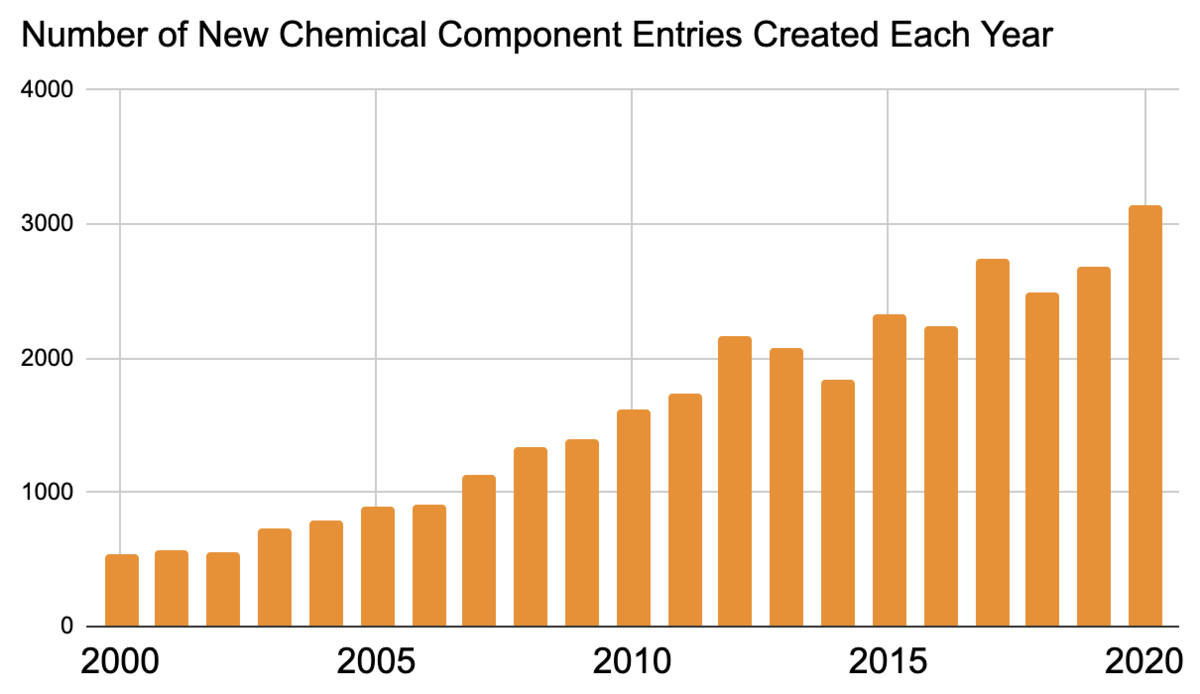
In addition, wwPDB also plans extended PDB ID length to eight characters prefixed by ‘PDB’, e.g., pdb_00001abc. Each PDB ID has a corresponding Digital Object Identifier (DOI), often required for manuscript submission to journals and described in publications by the structure authors. Both extended PDB IDs and corresponding PDB DOIs, along with existing four character PDB IDs, will be included in the PDBx/mmCIF formatted files for all new entries by Fall 2021.
For example, PDB entry 1ABC will also have the extended PDB ID (pdb_00001abc) and the corresponding PDB DOI (10.2210/pdb1abc/pdb) listed in the _database_2 PDBx/mmCIF category.
loop_ _database_2.database_id _database_2.database_code _database_2.pdbx_database_accession _database_2.pdbx_DOI PDB 1abc pdb_00001abc 10.2210/pdb1abc/pdb WWPDB D_1xxxxxxxxx ? ?
Once four-character PDB IDs are all consumed, newly-deposited PDB entries will only be issued extended PDB ID codes, and entries will only be distributed in PDBx/mmCIF format.
wwPDB is asking PDB users and related software developers to review code and begin to remove such limitations for the future.
[ wwPDB News ]
[wwPDB] New pdb-l Bulletin Board
pdb-l@lists.wwpdb.org is an open discussion forum for questions and discussions with the PDB user community about protein structure, analysis, and related topics. Messages sent to pdb-l@lists.wwpdb.org will be sent to all subscribers. This bulletin board, which supports HTML formatting and images, replaces the previous forum at pdb-l@sdsc.edu. Messages, including messages migrated from the previous bulletin board are archived.
Existing subscribers do not need to resubscribe. New users should visit the pdb-l@lists.wwpdb.org info page to subscribe.
If you have any questions regarding this migration or user subscription, please contact info@wwpdb.org.
Questions about PDB structures should be sent to deposit-help@mail.wwpdb.org.

[ wwPDB News ]
[wwPDB] Biocurator Milestone: >10,000 Depositions Processed
Congratulations to wwPDB’s Ms. Yumiko Kengaku on processing 10,000 depositions. Yumiko began her career as a biocurator in 2000, as a member the newly-formed PDBj team at her alma mater Osaka University. She is the 1st wwPDB biocurator to process more than 10,000 structures. Many Asian structural biologists know and trust Yumiko. For more than two decades, she has worked closely with depositors to expertly guiding them through the structure deposition process, ensuring timely release of high-quality data. A gift celebrating her long service to PDBj, the wwPDB, and the global scientific community was presented to Yumiko in April 2021. We look forward to celebrating the accomplishments of the next biocurator to reach the 10,000 deposition milestone.

PDBj Head Genji Kurisu and Ms. Yumiko Kengaku

[ wwPDB News ]
[wwPDB] Improved support for extended PDBx/mmCIF structure factor files
In October 2020, a subgroup of the wwPDB PDBx/mmCIF Working Group was convened to develop a richer description of experimental data and associated data quality metrics. Members of this Data Collection and Processing Subgroup are all actively engaged in development and support of diffraction data processing software. The Subgroup met virtually for several months discussing, reviewing, and finalizing a new set dictionary content extension that were incorporated into the PDBx/mmCIF dictionary on February 16, 2021. A reference implementation of the new content extensions has been developed by Global Phasing Ltd.
These extensions facilitate the deposition and archiving of a broader range of diffraction data, as well as new quality metrics pertaining to these data. These extensions cover three main areas:
- scaled and merged reflection data that have been processed to take account of diffraction anisotropy, by providing descriptors for that anisotropy, in terms of (1) a parameter-free definition of a cut-off surface by means of a per-reflection “signal” and a threshold value for that signal, and (2) the ellipsoid providing the best fit to the resulting cut-off surface;
- scaled and unmerged reflection data, by providing extra item definitions aimed at ensuring that such data can be meaningfully re-analysed, and their quality assessed independently from the associated model, after retrieval from the archive;
- anomalous diffraction data, by adding descriptors for numerous relevant, but previously missing, statistics.
The new mmCIF data extensions describing anisotropic diffraction now enable archiving of the results of Global Phasing’s STARANISO program. Developers of other software can make use of them or extend the present definitions to suit their applications. Example files created by autoPROC and BUSTER (version 20210224) that are compliant with the new dictionary extensions provided in a GitHub repository.
These example files, and similarly compliant files produced by other data processing and/or refinement programs, are suitable for direct uploading to the wwPDB OneDep system. Automatic recognition of that compliance, implemented by means of explicit dictionary versioning using the new pdbx_audit_conform record, will avoid unnecessary pre-processing at the time of deposition. This improved OneDep support will ensure a lossless round trip between data processing/refinement in the lab and deposition at the PDB.
wwPDB strongly encourages structural biologists to always use the latest versions of structure determination software packages to produce data files for PDB deposition. wwPDB also encourages crystallographers wishing to deposit new structures together with their associated diffraction data to take advantage of these new mmCIF dictionary extensions, as the software producing them can guarantee consistency between data and final model with a degree of confidence not easily achievable when separate diffraction data files and model coordinate files are pieced together a posteriori by ad hoc means. wwPDB also encourages depositors to make their raw diffraction images available from one of the public repositories to allow direct access to the original diffraction image data.
[ wwPDB News ]
[wwPDB] OneDep highlights curated assemblies for review in Mol*
To improve the clarity of assembly definitions in curation, wwPDB now makes curated PDB assemblies available for depositors to view in OneDep using the Mol* viewer.
One of the important processes in curation of PDB entries is the definition of assemblies for each structure. This helps users of PDB data to understand the structure in the context of its complex formation in the specific experimental conditions.
To ensure that assemblies are curated correctly, they are reviewed by annotators at the time of curation before being reported back to the depositors after the curation process.
The deposition system in OneDep has now been enhanced so that after curation, the annotated assembly is displayed in the Mol* 3D viewer for depositors to review. This viewer is available in a new Review section in the deposition interface, which is present after curation of the entry. The Mol* viewer can display PDB structure data within the browser with minimal memory requirements, therefore making it quick and easy to visually display assembly information.
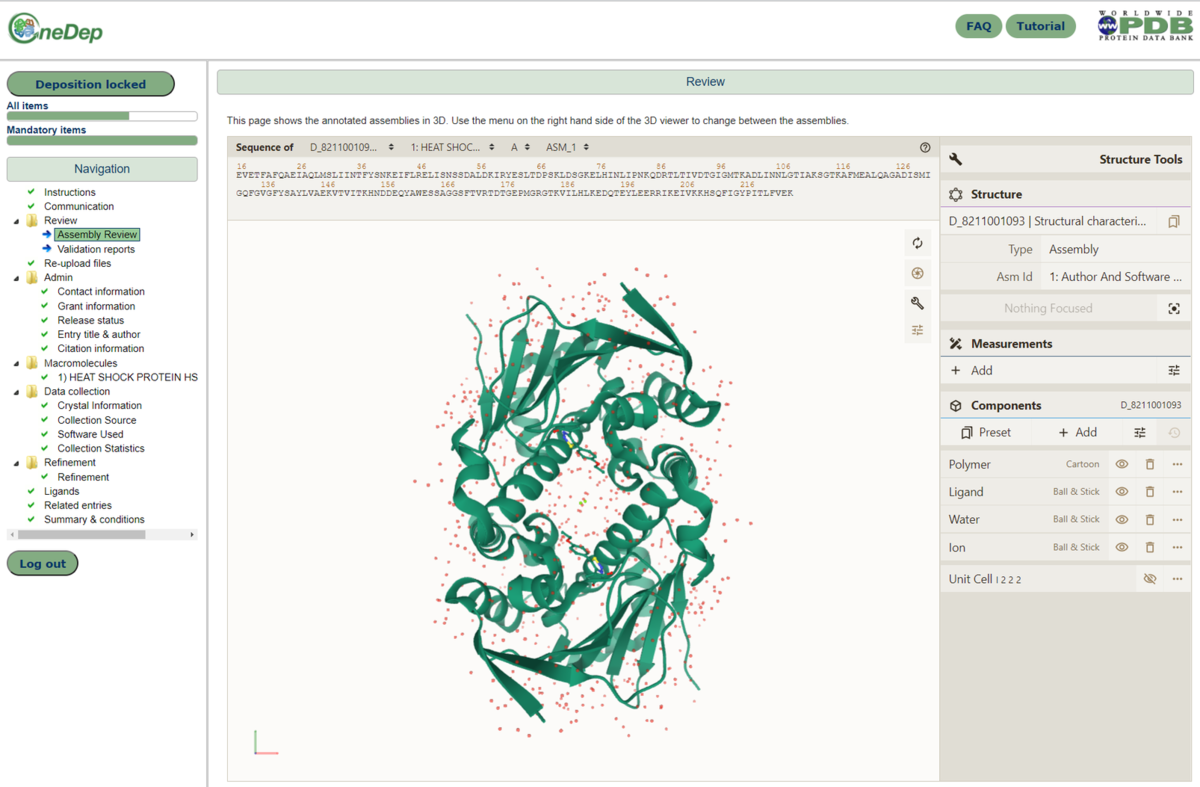 The assembly review page, as displayed for depositors after curation of the entry. The curated assembly is displayed in the Mol* 3D viewer, within the browser.
The assembly review page, as displayed for depositors after curation of the entry. The curated assembly is displayed in the Mol* 3D viewer, within the browser.
These changes will help to improve the validation of curated of assemblies for PDB entries and the clarity of reporting of these during the deposition process.
[ wwPDB News ]
[wwPDB] Modifications to support for SHEET and ligand SITE records in June 2021
In 2014, PDBx/mmCIF became the PDB’s archive format and the the legacy PDB file format was frozen. In addition to PDBx/mmCIF files for all entries, wwPDB produces PDB format-formatted files for entries that can be represented in this legacy file format (e.g., entries with over 99,999 atoms or with multi-character chain IDs are only available in PDBx/mmCIF)
As the size and complexity of PDB structures increases, additional limitations of the legacy PDB format are becoming apparent and need to be addressed.
Defining complex sheet records
Restrictions in the SHEET record fields in legacy the PDB file format do not allow for the generation of complex beta sheet topology. Complex beta sheet topologies include instances where beta strands are part of multiple beta sheets and other cases where the definition of the strands within a beta sheet cannot be presented in a linear description. For example, in PDB entry 5wln a large beta barrel structure is created from multiple copies of a single protein; within the beta sheet forming the barrel are instances of a single beta strand making contacts on one side with multiple other strands, even from different chains.
This limitation, however, is not an issue in the PDBx/mmCIF formatted file, where these complex beta sheet topology can be captured in _struct_sheet, _struct_sheet_order, _struct_sheet_range, and _struct_sheet_hbond.
Starting June 8th 2021, legacy PDB format files will no longer be generated for PDB entries where the SHEET topology cannot be generated. For these structures, wwPDB will continue to provide secondary structure information with helix and sheet information in the PDBx/mmCIF formatted file.
Deprecation of _struct_site (SITE) records
wwPDB regularly reviews the software used during OneDep biocuration. The _struct_site and _struct_site_gen categories in PDBx/mmCIF (SITE records in the legacy PDB file format) are generated by in-house software and based purely upon distance calculations, and therefore may not reflect biological functional sites.
Starting in June 2021, the in-house legacy software which produces _struct_site and _struct_site_gen records will be retired and wwPDB will no longer generate these categories for newly-deposited PDB entries. Existing entries will be unaffected.
[ wwPDB News ]
[wwPDB] Enhanced Validation of Small-Molecule Ligands and Carbohydrates
A new article in Structure describes new features, including branched representations and 2D SNFG images for carbohydrates, identification of ligands of interest, 3D views of electron density fit, and 2D images of small molecule geometry.
These enhancements and processes for validation of 3D small-molecular structures reflect recommendations from the wwPDB/CCDC/D3R Ligand Validation Workshop and the adoption of software through community collaborations.
This manuscript also highlights enhancements made since the initial implementation of Validation Reports as described in Validation of the Structures in the Protein Data Bank (2017) Structure 25: 1916-1927 doi: 10.1016/j.str.2017.10.009.
Enhanced Validation of Small-Molecule Ligands and Carbohydrates in the Protein Data Bank
Zukang Feng, John D. Westbrook, Raul Sala, Oliver S. Smart, Gérard Bricogne, Masaaki Matsubara,
Issaku Yamada, Shinichiro Tsuchiya, Kiyoko F. Aoki-Kinoshita, Jeffrey C. Hoch, Genji Kurisu, Sameer Velankar,
Stephen K. Burley, and Jasmine Y. Young
(2021) Structure doi: 10.1016/j.str.2021.02.004
[ wwPDB News ]
[wwPDB] Submit Abstracts for PDB50 by March 15
Throughout 2021, the wwPDB will be celebrating the 50th anniversary of the PDB archive (wwpdb.org/pdb50).
The inaugural symposium will be held virtually on May 4-5, 2021.
The online sessions will take place between 11 a.m. – 4:30 p.m. ET each day. The event will be recorded and made available to registered participants after the meeting.
Students and postdoctoral fellows are especially encouraged to attend and will be eligible for poster awards.
Abstract submission and reduced registration rates end March 15. Register at https://www.asbmb.org/meetings-events/pdb50.
Speakers
[ wwPDB News ]
[wwPDB] More than 1,000 SARS-CoV-2 Coronavirus Protein Structures Available
With this week's update, 1,018 SARS-CoV-2-related structures are now freely available from the Protein Data Bank.
The first SARS-CoV-2 structure, a high-resolution crystal structure of the coronavirus main protease (PDB 6lu7), was released early in the pandemic on February 5, 2020.
Since then, structural biologists have visualized most of the SARS-CoV-2 proteome, including the spike protein binding to its ACE2 receptor and neutralizing antibodies, and the main protease, the papain-like proteinase, and other promising drug discovery targets. All of the structures and related data are available for exploration from wwPDB partner websites: RCSB PDB, PDBe, PDBj, and BMRB.
Rapid public release of SARS-CoV-2 structure data has greatly increased our understanding of Covid-19, allowed direct visualization of emerging variants of the virus, and facilitated structure-guided drug discovery and reuse to combat infection. Open access to PDB structures has already enabled design of effective vaccines against SARS-CoV-2.
The response of the research community to the pandemic has highlighted the importance of open access to scientific data in real time. The wwPDB strives to ensure that 3D biological structure data remain freely accessible for all, while maintaining as comprehensive and accurate an archive as possible.
The impact of these 1018 structures and many more coronavirus protein structures to come stands as a testament to the importance of open access to structural biology research data.
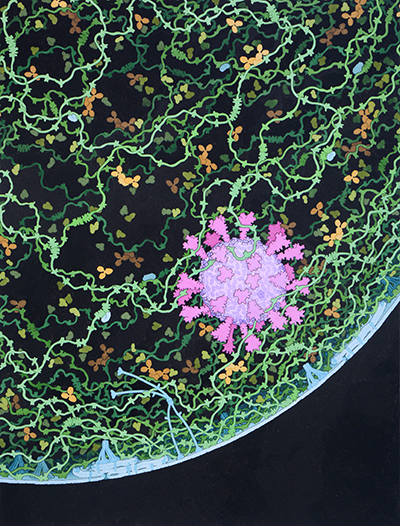
Illustration by David S. Goodsell, RCSB Protein Data Bank; doi: 10.2210/rcsb_pdb/goodsell-gallery-024
[ wwPDB News ]
[wwPDB] PDB50: Registration Open for Virtual Event
Throughout 2021, the wwPDB will be celebrating the 50th anniversary of the PDB archive.
The inaugural symposium will be held May 4-5, 2021 in an event hosted by the American Society for Biochemistry and Molecular Biology and organized by the wwPDB Foundation.
This celebration of the 50th anniversary of the founding of the Protein Data Bank as the first open access digital data resource in biology will include presentations from speakers from around the world who have made tremendous advances in structural biology and bioinformatics.
Attendees are encouraged to participate in the virtual poster session and exhibition hall. Students and postdoctoral fellows will be eligible for poster awards.
Register and submit abstracts by March 15th, 2021 for reduced rates.
Speakers will include:
- Edward Arnold - Rutgers, The State University of New Jersey
- Helen M. Berman - Rutgers, The State University of New Jersey and University of Southern California
- Thomas L. Blundell - University of Cambridge
- Alexandre M. J. J. Bonvin - Utrecht University
- Stephen K. Burley - Rutgers, The State University of New Jersey and University of California San Diego
- Wah Chiu - Stanford University
- Johann Deisenhofer - University of Texas Southwestern Medical Center
- Juli Feigon - University of California Los Angeles
- Angela M. Gronenborn - University of Pittsburgh
- Jennifer L. Martin - University of Wollongong
- Stephen L. Mayo - California Institute of Technology
- Zihe Rao - ShanghaiTech University and Tsinghua University
- Hao Wu - Boston Children's Hospital and Harvard Medical School
The online sessions will take place between 11 a.m. – 4:30 p.m. EST each day. The event will be recorded and made available to registered participants after the meeting.
Sponsorship opportunities are available; please contact the wwPDB Foundation for more information.
[ wwPDB News ]
[wwPDB] wwPDB EM Validation Reports Now Publicly Available
The wwPDB archive has now been updated to include validation reports for every released set of EM model coordinates in the PDB and every released EMDB map entry. Validation reports provide quantitative and visual assessments of structure quality and enable archive-wide comparisons (https://www.wwpdb.org/validation/validation-reports).
wwPDB EM validation reports were first made available to OneDep depositors in 2019 (wwPDB news). The current reports are based on recommendations obtained from EM Validation Task Force (VTF) meetings in 2010 (Structure 20: 205-214, wwpdb.org/task/em) and 2020 (white paper in preparation), as well as EM Validation Challenge events (https://www.ncbi.nlm.nih.gov/pubmed/32002441, https://www.biorxiv.org/content/10.1101/2020.06.12.147033v1). Examples of recent improvements include images for deposited masks, improved map-model overlay images, visualization of a (approximate) raw map from two half-maps, and rotationally averaged power spectrum plots. The underlying methodology is continually improved, based on community requirements, requests and feedback.
The PDB Core Archive holds validation reports that assess each PDB model along with its associated experimental map/tomogram from EMDB. EM map+model reports can be downloaded at the following wwPDB mirrors:
- wwPDB: ftp://ftp.wwpdb.org/pub/pdb/validation_reports/
- RCSB PDB: ftp://ftp.rcsb.org/pub/pdb/validation_reports/
- PDBe: ftp://ftp.ebi.ac.uk/pub/databases/pdb/validation_reports/
- PDBj: ftp://ftp.pdbj.org/pub/pdb/validation_reports/
The EMDB Core Archive holds validation reports that assess each EMDB map/tomogram entry. EM map-only reports can be downloaded at the following URLs:
- EMDB: ftp://ftp.ebi.ac.uk/pub/databases/emdb/validation_reports/
- wwPDB: ftp://ftp.wwpdb.org/pub/emdb/validation_reports/
- RCSB PDB: ftp://ftp.rcsb.org/pub/emdb/validation_reports/
- PDBj: ftp://ftp.pdbj.org/pub/emdb/validation_reports/
Additional information about validation reports is available for EM map+model, EM map only, and EM tomograms.
If you have any questions or queries about wwPDB validation, please contact us at validation@mail.wwpdb.org.
 Example of map-model overlay image: EMD-30388/7CWU, SARS-CoV-2 spike proteins trimer in complex with P17 and FC05 Fabs cocktail
Example of map-model overlay image: EMD-30388/7CWU, SARS-CoV-2 spike proteins trimer in complex with P17 and FC05 Fabs cocktail
[ wwPDB News ]



